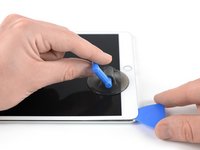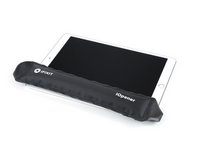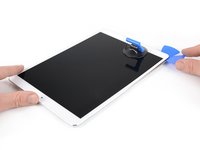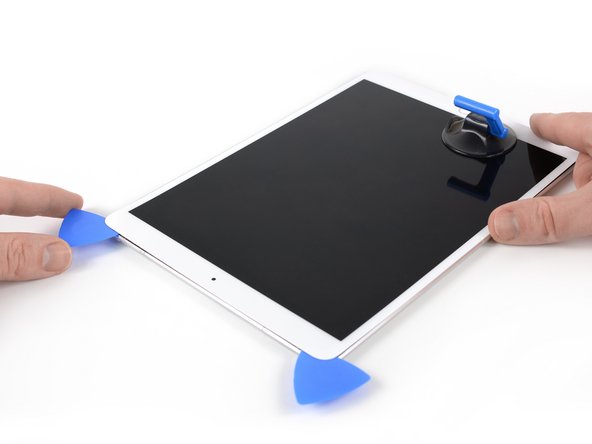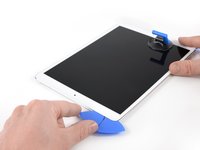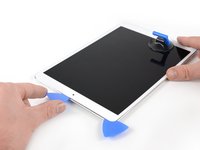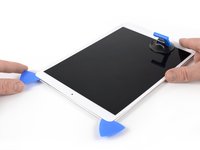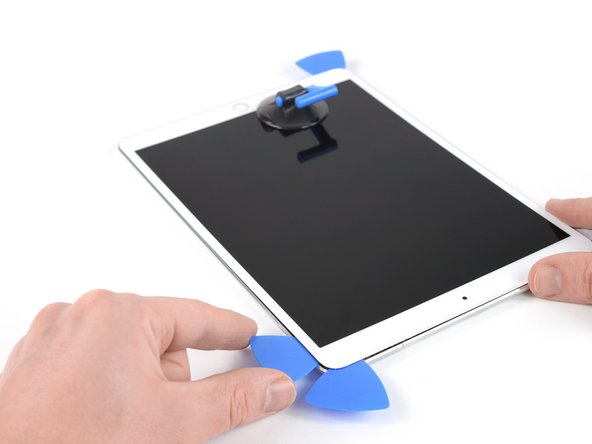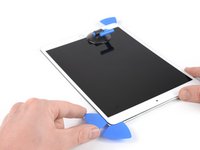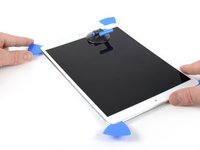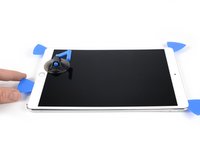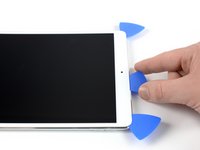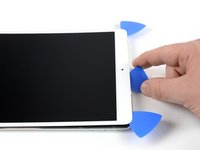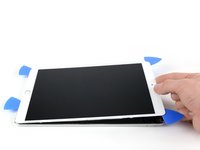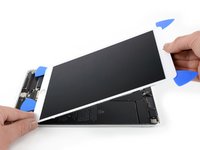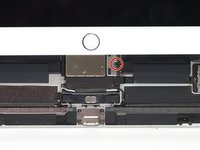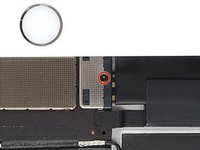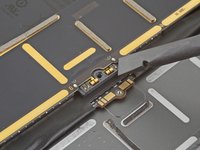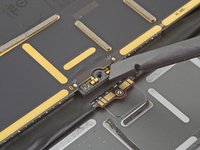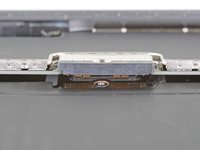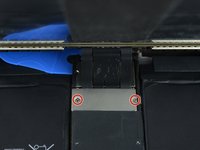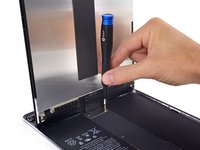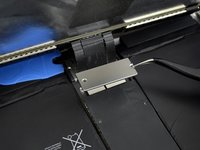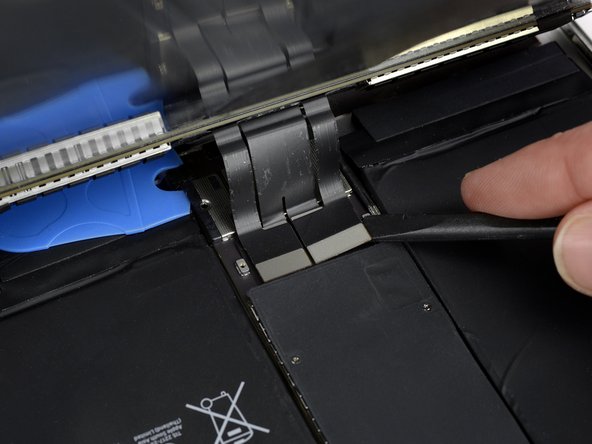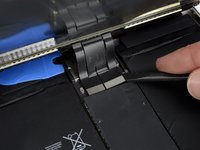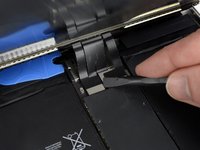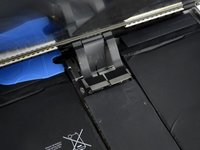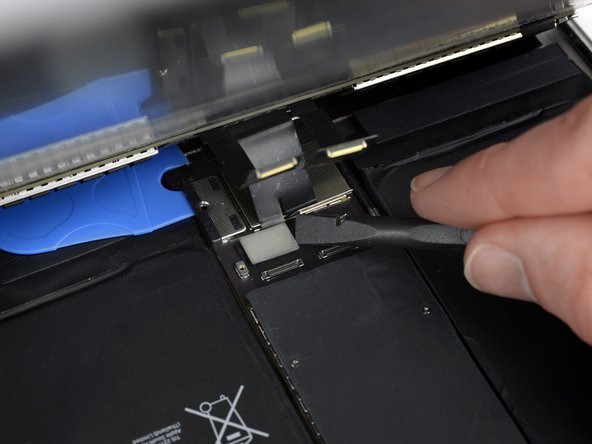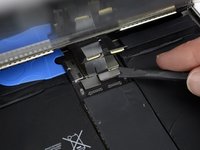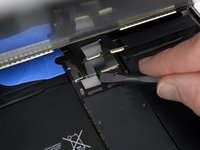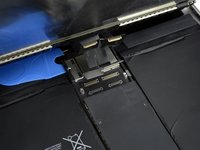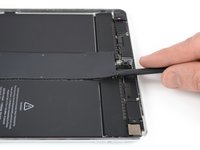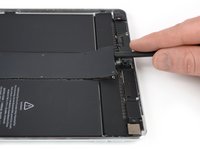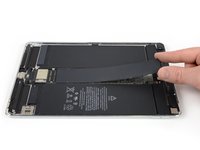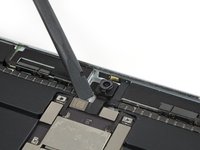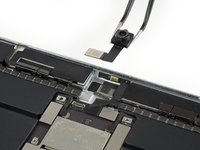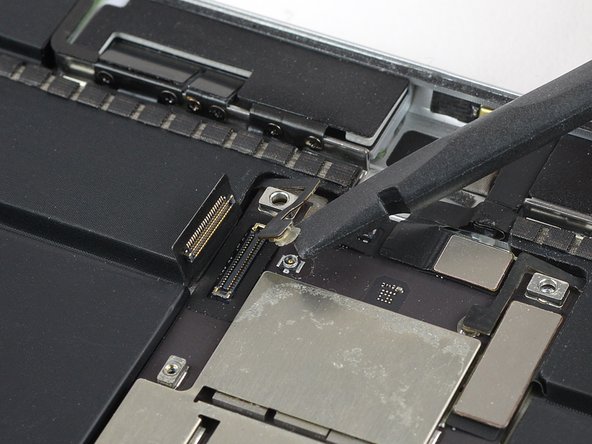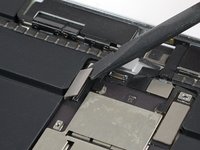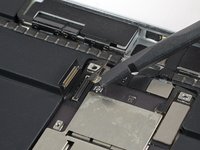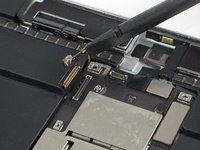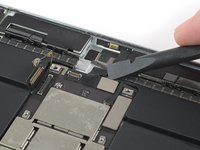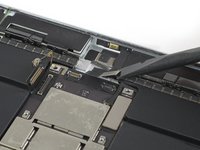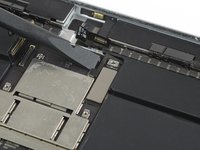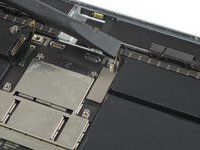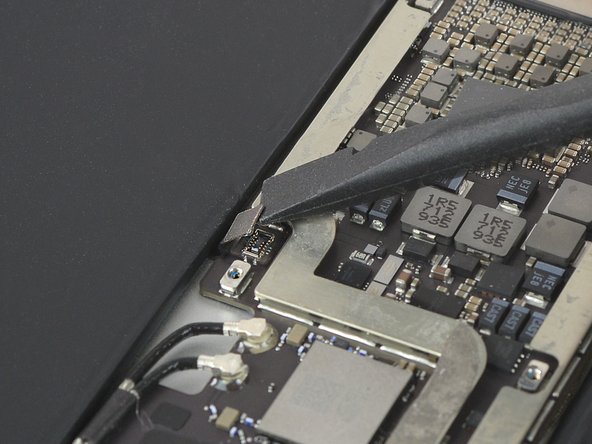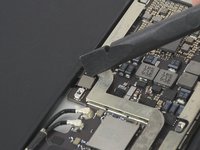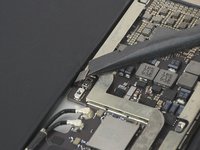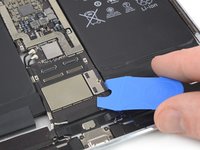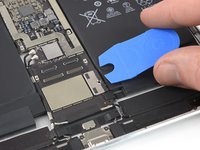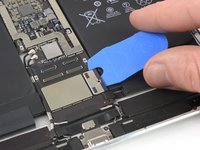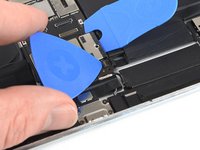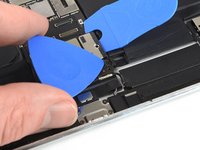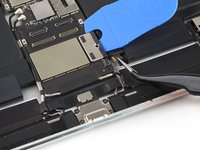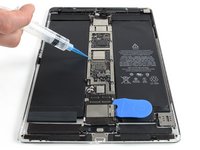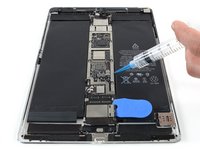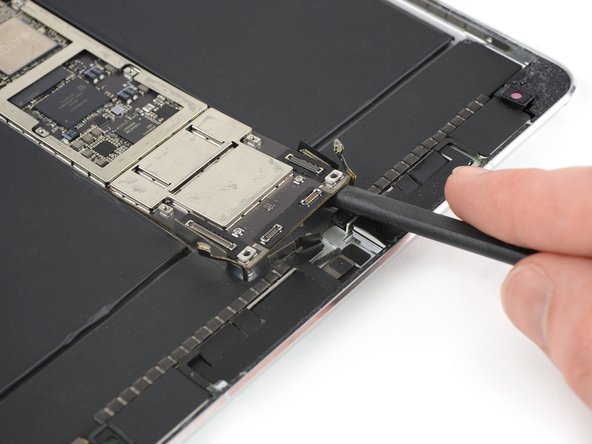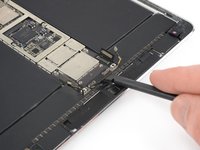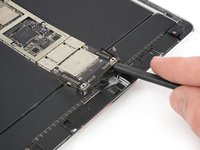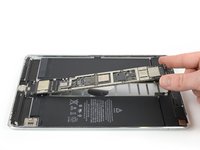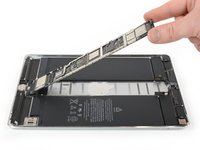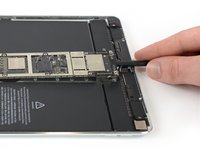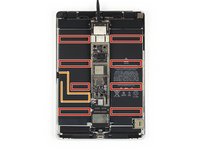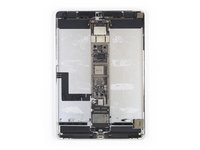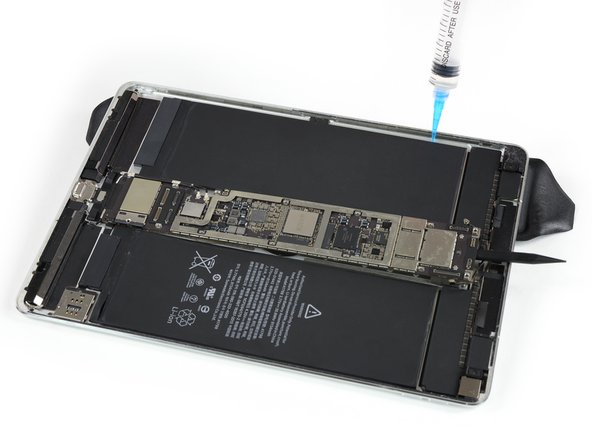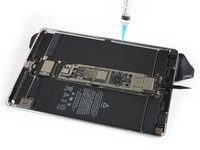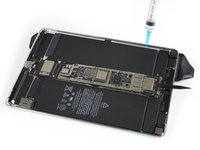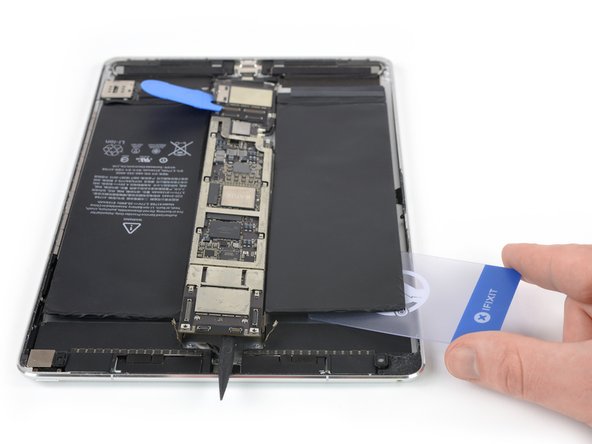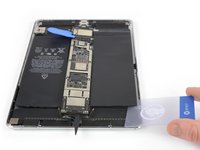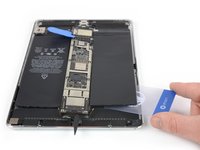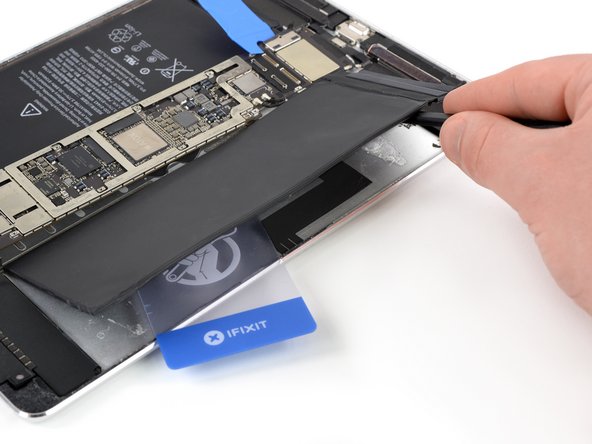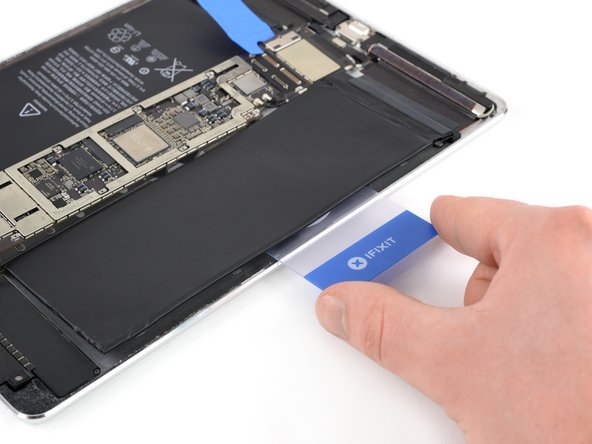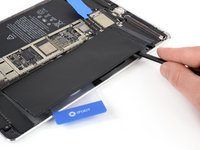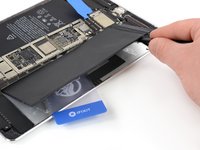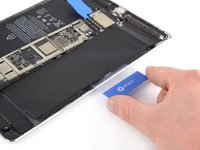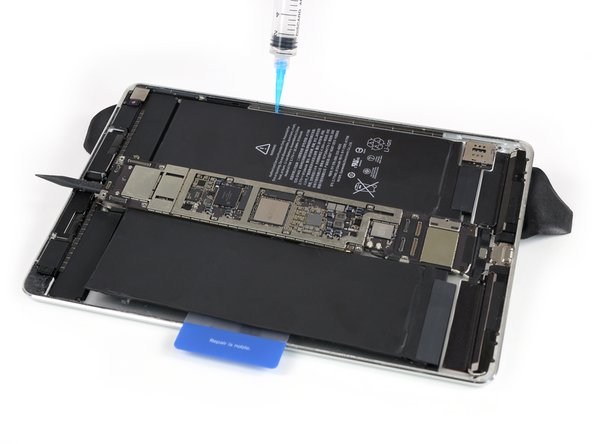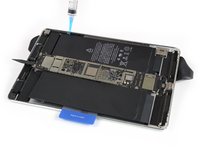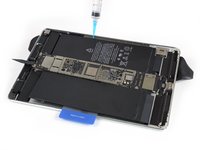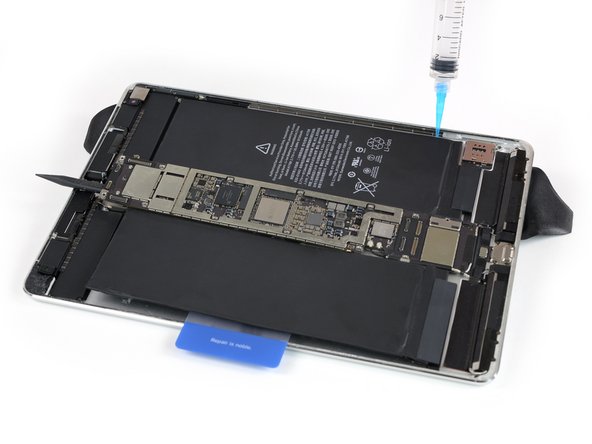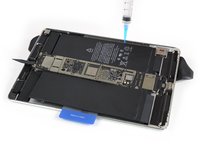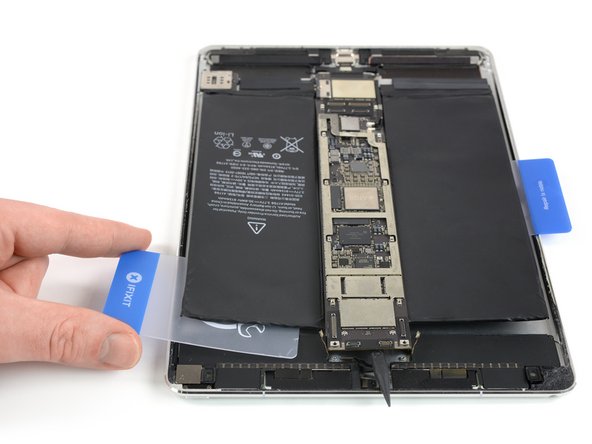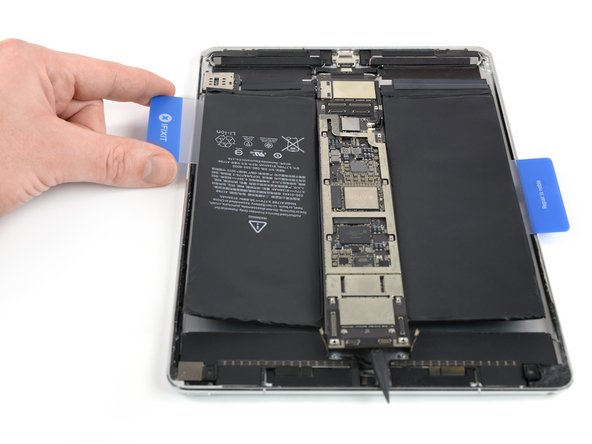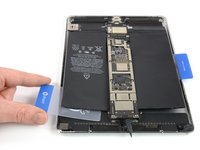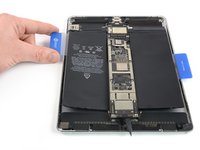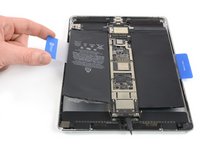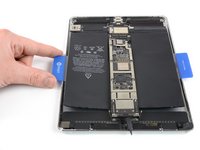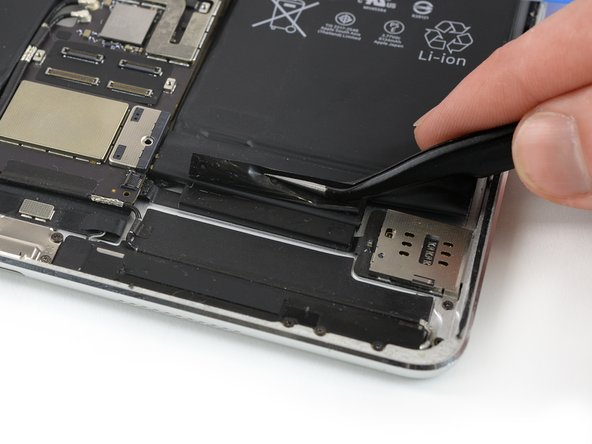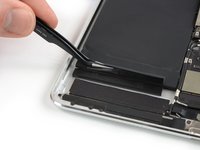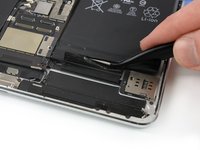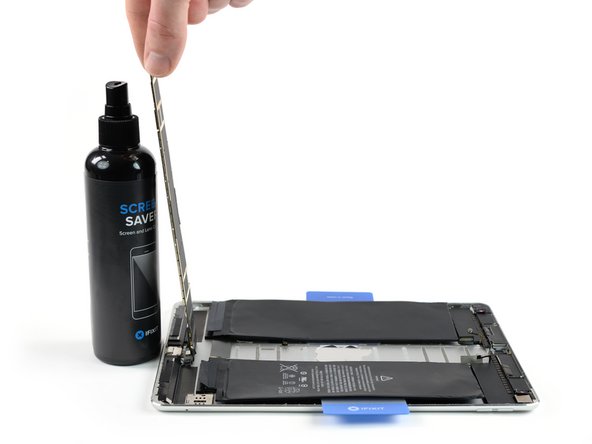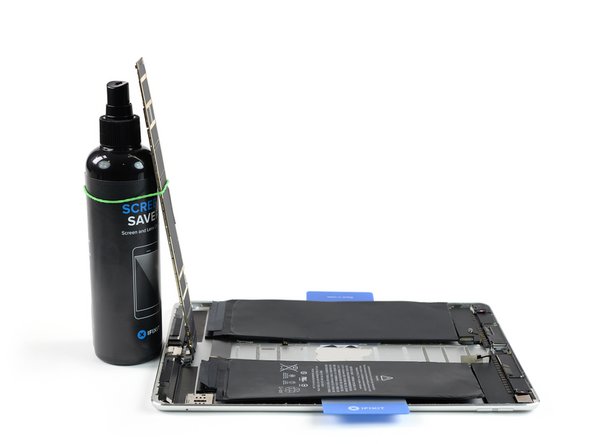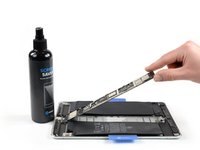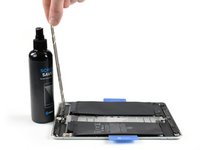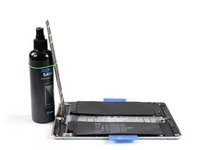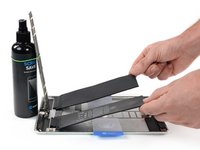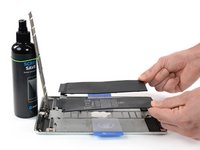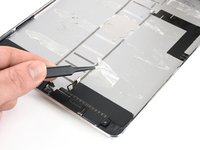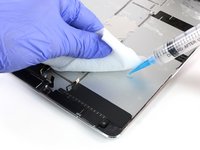crwdns2915892:0crwdne2915892:0
Use this guide to remove and replace the battery for the iPad Pro 10.5”.
Because there are steps in this guide where the battery may remain connected to the logic board, leave the iPad on until the battery is completely discharged (the iPad turns itself off) before attempting this guide. A charged lithium-ion battery can catch fire and/or explode if accidentally punctured.
Have plenty of high concentration (>90%) isopropyl alcohol to help make the removal and residue cleanup easier.
If your battery is swollen, take appropriate precautions.
crwdns2942213:0crwdne2942213:0
-
-
You may need to reapply heat repeatedly throughout this process to prevent the adhesive from cooling and hardening.
-
Prepare an iOpener and place it on the bottom edge of the iPad's screen for about two minutes.
-
-
crwdns2935267:0crwdne2935267:0Clampy - Anti-Clamp$24.95
-
Place a suction cup next to the iPad's home button and press down to create a seal.
-
Firmly pull up on the suction cup to create a small gap between the front panel and the rear case.
-
Once you've opened a sufficient gap, insert an opening pick into the gap.
i used a proper suction tile puller (small one from DIY store used to hold bathroom tiles) to lift the screen off after heating around the edge using a heat gun. Be careful - It didn't damage anything. The tiny suction things that come with those iPhone kits are not strong enough for this. The one in picture might be good, but looks similar to the kits ones that have key ring.
The suction cup that comes with the iPad battery replacement is plenty large enough and strong enough.
CAUTION, do not push the picks in more than a the width of the replacement screen adhesive strips. You will damage the $200 screen, maybe break the glass. The screen is multiple layers and the picks can get in-between the layers if you push too far in. I got into trouble at the lower left corner. After getting the screen loose, I found that I only need a 2-3 millimeters on the sides and bottom, and four or five millimeters in the corners.
These comments need to be highlighted and added to the guide. The pictures showing the pick placement are very misleading. The thickness of the adhesive is only 2mm as you had mentioned! Waiting now for my replacement screen. Apples products look amazing but now I realize I would have been way better off just living with a one hour battery and or buying a new ipad.
-
-
-
Slice through the adhesive under the screen by sliding the pick along the edge of the display, towards the bottom left corner.
-
Leave the pick in place temporarily to prevent the adhesive from re-sealing.
Be super carful at the sides! If you insert your pick more than ~2mm, you will separate your display and front glass.
-
-
-
Apply heat to the left edge of the iPad for about two minutes, or until it's slightly too hot to touch comfortably.
-
If necessary, re-heat your iOpener for a few seconds or until it's a bit too hot to touch. Be careful not to overheat the iOpener, or it may burst.
-
Insert a second opening pick at the bottom left corner of the iPad.
-
Slide the second opening pick along the left side of the display to separate the adhesive underneath.
-
Leave the opening pick inserted near the top left corner of the iPad to prevent the adhesive from re-sealing.
-
-
-
Apply heat to the top edge of the iPad for about two minutes, or until it's slightly too hot to touch comfortably.
-
-
-
Insert a third opening pick at the top left corner of the iPad.
-
Use the opening pick to cut the adhesive under the top edge of the iPad by sliding it to the top right corner.
-
-
-
Apply heat to the final, right edge of the iPad for about two minutes, or until it's slightly too hot to touch comfortably.
-
Insert a fourth opening pick at the top right corner of the iPad.
-
Slide the opening pick down to the bottom right corner to cut the adhesive.
-
Slide the opening pick around the bottom right corner—pausing to apply more heat if needed—and cut the remaining adhesive on the bottom edge, but stop before you reach the home button.
We must be very careful when we are prying left and right size bezel to peel off the screen as there very little gap between edges and LCD. Slightly inside push can crack LCD. We need to pay full care and raising edges very very slowly.
if you manage to get hold of the adhesiv strip, then pull it out slow and careful, that help a Lot !
-
-
-
Insert a fifth opening pick at the top of the iPad near (but not directly on) the front-facing camera.
-
Gently twist the pick to separate the display assembly from the iPad.
-
If needed, apply more heat and/or cut any remaining adhesive that prevents the display from separating.
Be very gentle when twisting. My screen broke in this step. I would not twist it but try to remove glue further as there is a aluminium support of the screen in the wide area beneath the light sensors and there is glue on that also preventing in easy lifting the screen. Just be careful not to damage the light sensors and camera.
-
-
-
Lift the display assembly from its top edge and carefully slide it up (towards the front-facing camera and headphone jack), until the screw that secures the battery power connector is revealed at the bottom.
How do you go about getting to this battery connector as it is covered by a large metal shield above the logic board, if you do not disconnect the battery you risk frying the back light.
The metal shield is not relevant for this. You can leave it in place or remove it if it comes of. Once the screw of the plate is removed you will be able to lift the print a little bit and put someting between the battery connector and the board connector. The connector is beneath the print. Look further on to see a deck card is used for this.
-
-
crwdns2935267:0crwdne2935267:0Magnetic Project Mat$17.96
-
Remove the 1.9 mm Phillips screw that secures the battery power connector.
What size Phillips bit?
In this whole guide I used 00 and 000.
-
-
This picture looks nothing like my A2152 battery connector. I can’t really tell what is happening here.
This is an iPad Pro not an iPad Air which is different.
Dan -
-
-
To disconnect the battery, slide one prong of a battery blocker or the tip of an opening pick under the battery power connector to ensure the power circuit is interrupted.
-
Leave the battery blocker in place as you work.
I found it very hard to fit something under the battery power connector. I did not have a battery blocker, so I tried a playing card. I was not able to slide it between the springs. The section of the battery power connector, above the cantilever springs, did not seem to want to give at all, like in the picture above. If other people had success, I would love to hear how.
I didn’t have success either, but i kept myself grounded, and avoided battery contact as much as possible.
I used a playing card cut to shape. I had to make a couple, to try a few times.. It does go in eventually. Not deep, but enough to break connection. You can test by trying to switch on iPad.
It took some time but I was able to get it under the back part and slide it forward.
You must disconnect the battery before plugging the new screen. I think i didn't break the circuit in first attempt and shorted the screen, the result was half of the screen didn't work. I used a playing card. Second attempt was successful with new screen.
I believe I have a good solution to this problem. I was dissatisfied with the thickness of the battery blocker, or even a thin guitar pick, for that matter; both required force and I feared bending the springs or leaving the connection intact.
What worked for me was cutting a small strip of non-conductive, static-proof film (the kind that RAM and other sensitive components come in). There was every reason to trust in its non-conductivity but just to be sure, I used a VOM to test; its resistance was out of the VOMs range, meaning that its conductivity was nil. I used a spudger to gently lift the logic board off of the battery contacts and slid the non-conductive strip in between; went without a hitch.
When reassembling, I laid the strip on the battery contacts, laid the logic board on top, installed it, connected the display panel and gently drew the slip out and installed the battery screw. Worked like a charm.
These are some extremely misleading set of instructions and picture. Much better if you have the battery discharged, so don't need to worry about blocking the connector. But DO NOT force anything in the through the socket and certainly do not try to bend up the soldered cover, as it appears to be happening in the picture. You will break the connector, most likely resulting in ipad shutting down every 3 minutes from the notorious "thermal sensor missing" panic system crash.
I like the method used in this video to block the battery. Seems superior to the instructions here.
I skipped this part entirely and now its not turning on after i screw on the screw, did I break the connector?
-
-
-
Slowly lift the display from its top edge, being careful not to strain the attached ribbon cables.
-
Remove the two 1.3 mm Phillips screws securing the display connector cover bracket.
-
Remove the display connector cover bracket.
Here it is very precocious steps to do. Flx cables to connectors are small in size and we cannot lift the display vertically. Therefore, we may struggle to unscrew the metal shield. We need to use smaller size of philip screw driver or place vertically the display to create enough gap between philip screw driver and the cover bracket. Similarly, when we are replacing new display we need to be carefully connect four flex cable with connectors with logic board.
agree, with re-assembly very tiny screws and awkward positioning, the back two cables pop off if not careful.
I did this step using just the tip of the PH000 screwdriver, it made it much easier to get my hands into the small space, the replacement screen from ifixit had tighter cables that I was not comfortable stretching out to go to a 90* angle to screw back on. Make sure your tip is magnetized for best results :)!
Meaning no disrespect for this excellent guide, I found this photo to be a bit misleading; at least in my case. It clearly shows about 90˚ between the case and the display. I tested the limits with the one I was repairing and could find no way to raise the display far enough to clear a screwdriver without jeopardizing the cables. I resorted to the same solution that Amber Wooldridge discovered; using a PH000 bit and hand-tightening. I had a tiny needle-nosed plier that I used to tighten them a bit (but very gently).
-
-
-
Use a spudger to disconnect the two visible display flex connectors by gently prying them straight up from their sockets.
-
-
-
Use your spudger to gently pry them up and disconnect them.
I went to replace the LCD assembly on an ipad Air 3, and one of the flex cables on the new LCD assembly broke in half. The flex cables on the old assembly work well and are intact. Is it possible to transfer the old flex cable(s) to the new assembly, or can I solder the broken pieces of the new flex cable together? I have also contacted the part supplier about this and am awaiting a response.
-
-
-
-
Remove the display assembly.
Definitely test your iPad’s functions before sealing it up. I needed to reopen the display to reconnect the display connectors in order to have the display functioning properly. As a result, the adhesive strips did not work as well and I needed to tape some of the edges closed with a small section of strong clear packing tape.
I stuck the adhesive to the chassis first. That was messy because the plastic that covers the adhesive seems to be for screen side first. So you end up exposing both sides and those collect dust. I now realise you're supposed to put the adhesive on screen first. Not sure if it would have made much difference in the outcome (mine screen is not stuck in some places).
I found this out too. I had two sealing kits and they were both meant to be fixed on the screen first. I did not managed to get the screen to stick with the body as well. Now used some B6000 glue in addition.
agrior -
When cleaning, apply alcohol to the cloth, not the edges of the screen, because it might get inside the screen.
-
-
-
Use a Phillips screwdriver to remove the ten screws securing the EMI shield:
-
Eight 1.3 mm screws
-
Two 2.3 mm screws
The top two screws are longer than the rest on my iPad. Be careful to put them back in the right spots.
-
-
-
Apply a heated iOpener to the EMI shield to loosen the adhesive beneath. Apply the iOpener for at least two minutes.
-
-
-
Use flat end of a spudger to pry up the EMI shield, starting from the top edge near the front-facing camera.
-
Continue carefully prying up the EMI shield until you can remove it.
The two screws adjacent to the camera location are slightly longer! Make sure you don’t mix them up with the other eight, as shorter ones will not work in this location.
Thanks! I’ve updated the step with your tip!
Don’t go rooting around too hard with the spudger or you will wipe components and be really mad cause you gotta solder them back on.
-
-
-
Use the edge of a spudger to pry up and disconnect the flex cable for the front-facing camera.
-
Remove the front-facing camera.
-
-
-
Use the edge of a spudger to pry up and disconnect both the left interconnect cable and antenna cable. Fold them gently out of the way.
wo finde ich das AntennenKabel , das ist abgerissen ?
Wo finde ich das Antennenkabel rechts und links das ist bei mir abgerissen ?
We also have no antenna cable as shown…
I think you need to assume that there is glue present and apply heat anyway. In my case the cable was not glued to the board but the connector was. So when I tried to gently lever the connector up, the cable ripped off the connector.
If you look at the picture shown in step 21, you can actually see the glue on the connector.
The left and right small antenna connectors are extremely delicate! They can crack if bent back too much and it's difficult to avoid bending them too much when removing and re-installing the logic board. This will cause the cellular radio and GPS to be inoperable. To be safe, remove antenna assembly (not shown in this guide) prior to removing the logic board.
To add to my comment, I'm actually working to replace the left and right small antenna connectors due to me breaking them. I'd recommend removing the top left and right speakers and just fully removing the two antenna connectors prior to removing the logic board. You do not need to fully remove the cellular antenna assemblies, just unscrew the plate/connector (with annoying perpendicular screws too) that cover the other ends of the small antenna connectors (easy to figure out once you remove the speakers).
To remove the speakers remove 3 screws, then just pry carefully (they have adhesive tape holding them down).
Antenna cable is only present if you have a model with cellular connection
-
-
-
Use the edge of a spudger to pry up and disconnect the microphone array cable.
-
-
-
Use the edge of a spudger to pry up and disconnect both the right interconnect cable and antenna cable, and gently fold them out of the way.
-
-
-
Use the edge of a spudger to pry up and disconnect the cable for the Smart Connector, and fold it out of the way.
-
-
-
Remove the Battery Blocker from the battery power connector.
-
Slide one side of the Battery Blocker under the battery power connector, and ensure that it doesn't cover the ZIF connector for the SIM card tray flex cable.
What should I do to block the battery instead?
"The battery isolation pick or battery blocker is an outdated way of isolating the battery, as you risk damaging the battery pins underneath the logic board."
As the previous comment says, if this is an "outdated way" then what is the up to date way?
I used small pieces of playing card. Not Very esd safe but effective
I had some success with using anti-static packaging, like iFixit parts come in.
-
-
crwdns2935267:0crwdne2935267:0Tweezers$4.99
-
Use a pair of tweezers to peel off the tape that covers the ZIF connector for the SIM card tray flex cable.
-
-
-
Use an opening pick to flip up the locking flap on the ZIF connector.
-
Use a pair of tweezers to pull out and disconnect the SIM card tray flex cable.
I don't have this connector on my 10.5 Pro. Maybe this is only for equipment with cellular. This needs to be confirmed by an expert.
You are correct, this is only for models with the cellular option. Wifi-only models can skip this step.
-
-
-
Apply some solvent in a seamless movement along both edges of the logic board. Allow it to penetrate the adhesive for several minutes.
I didn’t remove the logicboard. Remove the screws from the charging port. Remove the two antenna cables and separate them from each other by cutting the tape in between. Remove the two speaker cables. Now you should be able to pull or push the charging port out of his socket of the case and pull it up. There is little but enough room to move it. Pay attention to both of the antenna and speaker cables that there are not in the way when you remove the battery. You would slide out the battery by pushing it out underneath the charging port.
I used dental floss to remove the battery slowly and carefully. Don’t hurt any cables and ports underneath or next to the battery.
I'd love to see some photos of where to cut tape and move cables. I'm not quite confident enough to try that on my own, but removing the rest of the logic board looks difficult.
It's less scary than it sounds. Just follow the directions and watch the connectors.
Calion -
-
-
-
Insert the flat end of a spudger between the logic board and the rear case of the iPad.
-
Use the spudger to slowly pry up the right side of the logic board.
-
Pry up the left side of the logic board until you can get a good grip.
-
-
-
Lifting from the top edge, swing the logic board upwards to a 45° angle to ensure all adhesive beneath is separated.
-
Use a spudger or opening pick to separate any remaining adhesive as needed.
-
-
-
Set the logic board back down, leaving the spudger underneath to prevent the adhesive from re-sealing.
-
Adhesive
-
Smart Connector cable
-
-
-
Elevate the left side of the iPad (long edge nearest the headphone jack) by placing an iOpener underneath, so that the iPad lays down at an angle.
-
-
-
Apply some solvent underneath the battery at the three separate points where the longer adhesive strips are located. Only apply the solvent point by point and not in a seamless movement.
-
Allow the solvent to penetrate for several minutes to help weaken the adhesive.
-
-
crwdns2935267:0crwdne2935267:0Plastic Cards$2.99
-
Remove the iOpener so the iPad lays flat, and rotate it so the headphone jack faces towards you.
-
Insert a plastic card underneath the battery cell, starting near the outer corner.
-
Wiggle the card from side to side and push it under the battery to separate the adhesive underneath.
-
-
-
Carefully insert a spudger underneath the battery at the same hight as the display connectors. You might need to reapply an iOpener or adhesive remover.
-
Pry up the battery using the spudger and cut the remaining adhesive with it.
-
Lift the battery with the spudger to ensure all the adhesive is loosened.
-
Place the plastic card under the center of the battery cell, and leave it there to prevent the adhesive from re-sealing.
-
-
-
Elevate the right side of the iPad (long edge, nearest the rear camera) by placing an iOpener underneath, so that the iPad lays down at an angle.
-
Apply some solvent underneath the battery at the two leftmost adhesive strip locations.
-
-
-
Continue separately applying solvent at the remaining two adhesive strip locations. Allow it to penetrate for several minutes to help weaken the adhesive.
-
-
-
Remove the iOpener so the iPad lays flat, and rotate it so the headphone jack faces towards you.
-
Insert a plastic card underneath the battery cell, starting near the outer corner.
-
Wiggle the card from side to side and push it underneath the battery to separate the adhesive underneath.
-
Slide the plastic card down toward the bottom edge of the iPad and cut all the adhesive beneath the battery cell.
-
-
-
Lift the battery cell slightly to ensure all the adhesive is separated.
-
Leave the plastic card under the battery to prevent it from re-adhering.
-
-
-
Peel up the black adhesive strip at the bottom edge of each battery cell, if they didn't already come off during the prying procedure.
-
-
-
Lifting from the top edge, swing the logic board up until it's roughly perpendicular to the iPad.
-
Prop the board up securely so it doesn't move while you work. (Don't use anything metallic or conductive.)
-
-
-
Get a good grip on both sides of the battery and remove it from the iPad.
-
-
crwdns2935267:0crwdne2935267:0Tesa 61395 Tape$5.99
-
Use a pair of tweezers to peel off the remaining adhesive strip parts.
-
Clean the glued areas with isopropyl alcohol and a lint-free cloth before installing a new battery to ensure the new battery fits and the adhesive bonds correctly.
After a successful battery replacement we ran into an issue where the iPad Pro would crash once or twice a day. I made sure to calibrate the battery per repair instructions but that didn’t fix the issue. I got it resolved after backing up the iPad and then putting it into DFU mode through iTunes and installed a fresh copy of iPadOS and then restore from backup. That fixed the issue of iPad crashing. Hope this helps if you run into a similar issue.
-
Compare your new replacement part to the original part. You may need to transfer remaining components or remove adhesive backings from the new part before installing.
To reassemble your device, follow these instructions in reverse order.
If possible, turn on your iPad and test your repair before resealing the tablet.
For optimal performance, calibrate your newly installed battery after completing this guide: Charge it to 100% and keep charging it for at least 2 more hours. Then use your device until it shuts off due to low battery. Finally, charge it uninterrupted to 100%.
Take your e-waste to an R2 or e-Stewards certified recycler.
Repair didn’t go as planned? Check out our Answers community for troubleshooting help.
Compare your new replacement part to the original part. You may need to transfer remaining components or remove adhesive backings from the new part before installing.
To reassemble your device, follow these instructions in reverse order.
If possible, turn on your iPad and test your repair before resealing the tablet.
For optimal performance, calibrate your newly installed battery after completing this guide: Charge it to 100% and keep charging it for at least 2 more hours. Then use your device until it shuts off due to low battery. Finally, charge it uninterrupted to 100%.
Take your e-waste to an R2 or e-Stewards certified recycler.
Repair didn’t go as planned? Check out our Answers community for troubleshooting help.
crwdns2935221:0crwdne2935221:0
crwdns2935229:060crwdne2935229:0
crwdns2947412:017crwdne2947412:0
Is the black tape needed at bottom of battery when reassembling?
If you say the “the battery isolation method in this guide is outdated” then what is the correct way to isolate the battery?!?! The rest of the guide makes no mention of the correct/prefered method of isolating the battery.
How is it that the author took the time to update the guide with that message but failed to mention what should be done instead
We will never know why since only the author will know this. ¯\_(ツ)_/¯
Hi can you advise please? In step 25 the SIM card tray flex cable is disconnected, no problem apart from i don’t have a SIM card tray flex cable in the A1701 that i’m repairing!! Urgent assistance required please. Regards R
You have the Wi-Fi model, which will look slightly different and have different procedures compared to the cellular model. You can skip the SIM flex cable step.
Ich habe diese Antennenkabel defekt wo bekomme ich sie oder für was sind die ?
hi
I fixed my battery according to the guide.
I have two problem
1. battery screw not able screw back in. but I am able to turn on iPad.
2. after turning on I am not able to unlock because on the keypad 1, 2, 3, these keys not responding to the touch. all other keys are touch responsive.
kindly help me with these two issues.
many thanks
I just finished following this guide, thank you so much for writing it!
I know that 18 of the 43 involve dealing with glue, but JEEZ that’s still underselling how much glue is in this thing.
The iOpener worked surprisingly well for removing the display. But the iFixit adhesive remover was not effective for removing the old battery. After 5 minutes, the solvent only ate around the edges of the adhesive strips and made a huge gooey mess with the center still sticky. After 10 minutes the glue had already re-adhered. I recommend anyone reading this try heat first, and see whether that works for you.
FWIW, I skipped the steps with the battery blocker since there doesn’t seems to be consensus on how to do it safely. I just made sure the battery was completely dead so the backlight couldn’t turn on and fry anything even if it wanted to.
Either way, after about 3 hours start to finish including cleanup (man there was a lot of cleanup) I’m very happy to say that I have a new battery and everything is working perfectly!!
thanks for the guide, after fighting against the glue, and sweeting like i was running a marathon i just replaced the stupid battery, the only problem, its that the top right speaker sounds baad, like its loose or something, and its weird, because i never touch it, ill try to open it tomorrow and see what's the problem
The guide should include a warning not to clean the glue around the edges of the screen after opening. Or, at least not use any solvent. Any liquid you use will leak in between the digitizer and LCD, hence ruining your display. Another comment though, why the battery I bought like two weeks ago is made in May of 2019?
I was lucky enough to take off the adhesive from the Logic board and the battery without using any solvents and used just my hair dryer. You definitely need to be patient with the process and not force it. Putting the new battery back on, as well as putting back on the display, and camera was super quick. Those darn new screen adhesives are a pain to put on but once the screen sits flush with the body, it was totally worth it. Think I spend about an hour and a half total. Battery isolation with the little pick did help out and felt safe having it in place throughout the repair process. Having the locations of where the battery adhesives were located, as well as the Smart connector was super clutch! I appreciate the disclaimers and warnings all throughout the repair guide.
Just to provide some failing experience and heads-up: My LCD screen has cracks and flickering after the battery replacement. I think it’s because when removing the screen I used the suction cup too frequently and added too much pressure to the screen when using it. Try to use the iOpener and the pick for most of the time for removing the screen.
I didn’t remove the logicboard. Remove the screws from the charging port. Remove the two antenna cables and separate them from each other by cutting the tape in between. Remove the two speaker cables. Now you should be able to pull or push the charging port out of his socket of the case and pull it up. There is little but enough room to move it. Pay attention to both of the antenna and speaker cables that there are not in the way when you remove the battery. You would slide out the battery by pushing it out underneath the charging port.
I used dental floss to remove the battery slowly and carefully. Don’t hurt any cables and ports underneath or next to the battery.
I also managed to replace the battery by using the tip loosening antenna and speaker cables + sim ribbon and then unscrewing charging port. This makes all this a much simpler operation as logic board can stay in.
i just did it succesfully; took me 4 hours and 5 screws are left-over now, since their lock nut came off the motherboard since I spilled some isoprop on it by accident. hopefully everything works and holds no matter what
@arthurshi, has there been any update to the battery isolation issue in Step 25 in the last four ½ years?
Following the battery calibration procedure exactly...what is everyone's experience with usage after doing this? Are you all finding the battery life is as good as could be expected? When I did my battery calibration, it took FOREVER for the battery to go from 99% to 100% the first time charging up, and then after waiting the additional 2 hours, I turned the brightness all the way up and ran Youtube to run the battery down....and it only lasted about 5 hours, which is worrisome to me. Anyone else experience this?






